The quarterly forecast call. For many sales leaders, it’s a moment of high anxiety, defined by a frantic scramble to cobble together data from disparate spreadsheets, CRM reports, and the subjective “gut feelings” of their reps. This traditional process is not just stressful; it’s dangerously unreliable. The business impact of getting the forecast wrong is severe, cutting both ways with damaging consequences. When a company over-forecasts and subsequently under-delivers, the fallout can be catastrophic. It erodes credibility with the board and investors, leads to misallocated budgets, and can culminate in painful layoffs and a depressed company valuation. Conversely, the hidden costs of under-forecasting-often dismissed as a “good problem to have”-are just as corrosive. Over-delivering on a conservative forecast means the business missed critical opportunities to invest in growth. It failed to hire key personnel, ramp up marketing spend, or expand into new markets, effectively ceding ground to more aggressive competitors.
In this high-stakes environment, a new class of technology has emerged to replace the crystal ball with data science: the smart revenue forecasting engine. This represents a fundamental paradigm shift, moving organizations from reactive guesswork to proactive, data-driven strategic planning. This deep dive will demystify how these intelligent engines operate, explore the critical data that fuels their accuracy, and demonstrate why a robust Revenue Orchestration platform is the non-negotiable foundation for achieving truly predictable revenue.
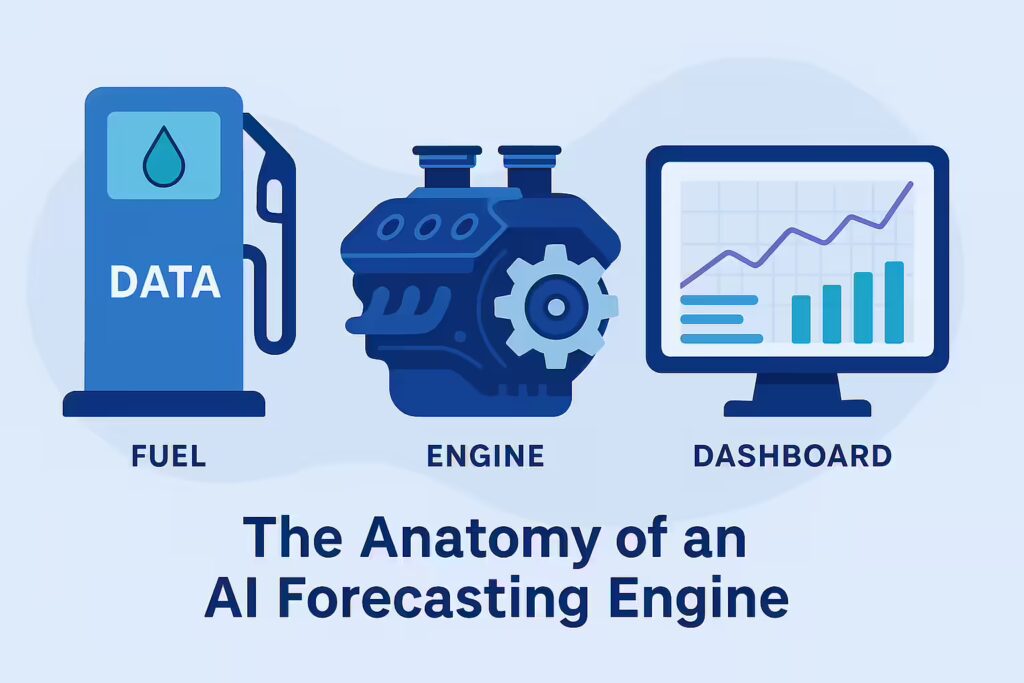
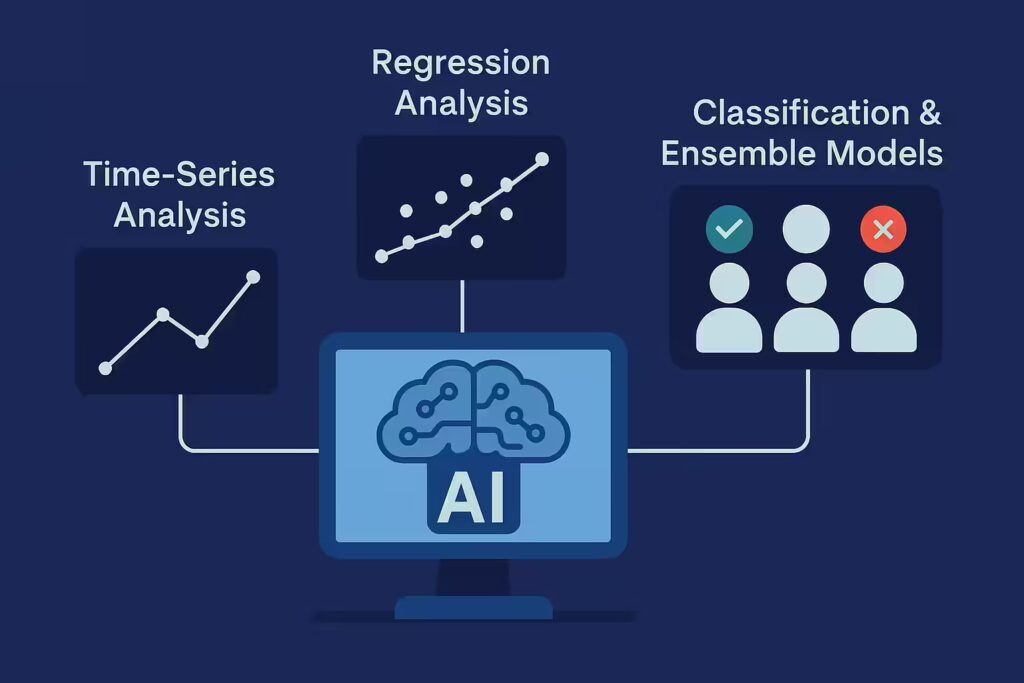
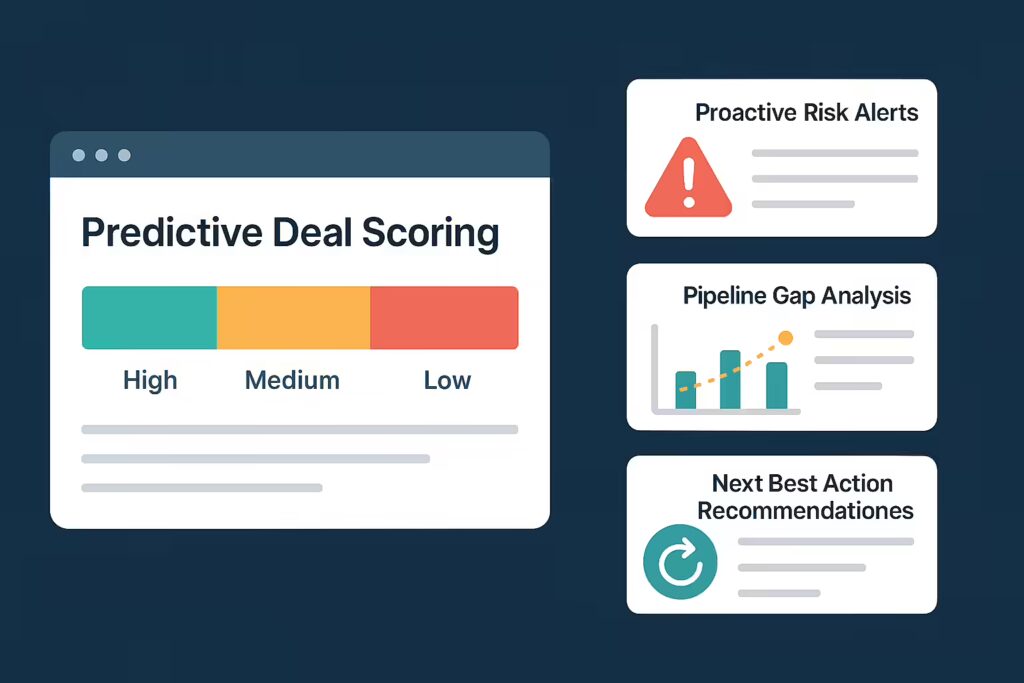
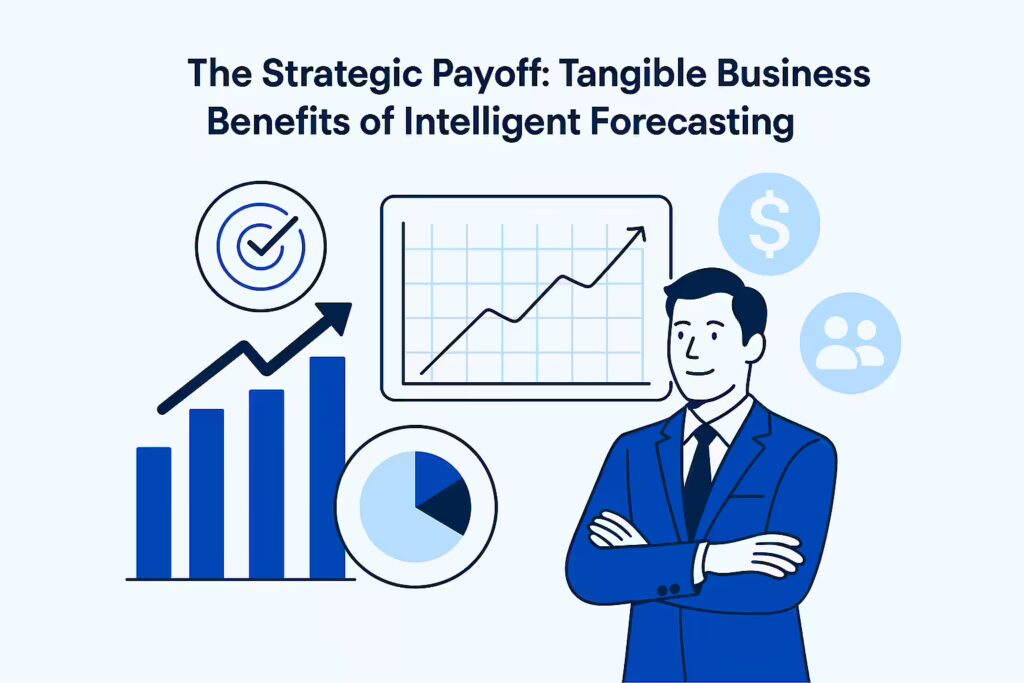
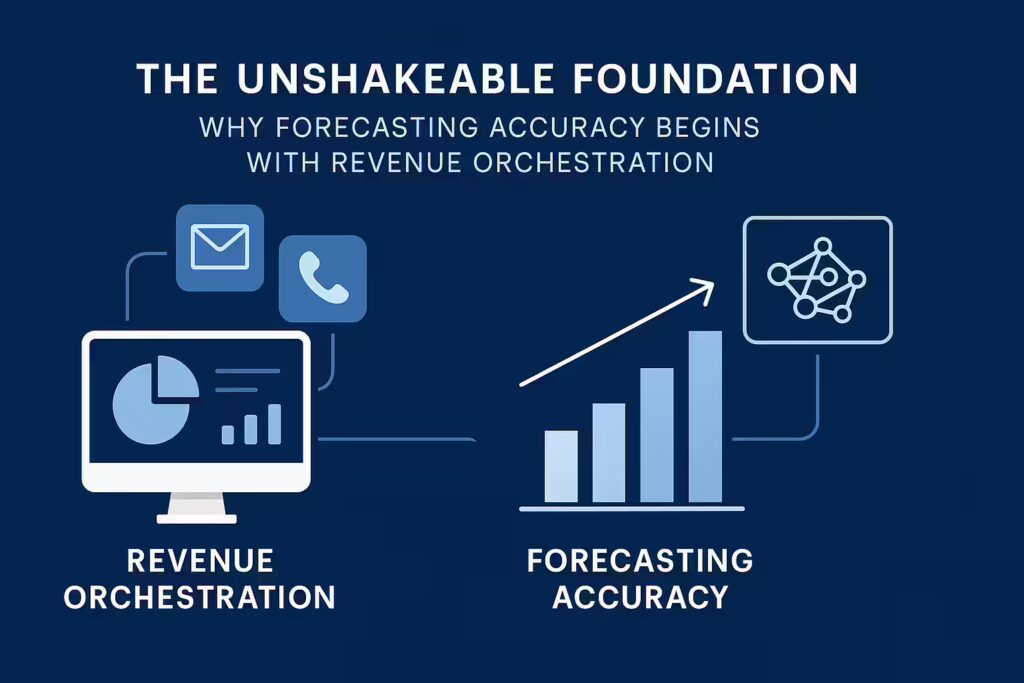
Redefining the Forecast: What Makes an Engine “Smart”?
A smart revenue forecasting engine is a system that leverages artificial intelligence (AI) and machine learning (ML) to process vast and complex datasets, identifying patterns to predict future revenue with a high degree of accuracy. This stands in stark contrast to traditional, manual methods, which are inherently limited by human capacity and plagued by cognitive biases like over-optimism or conservative “sandbagging”. The key differentiator is the AI itself. While a human analyst might track a handful of variables, an AI model can analyze hundreds or even thousands simultaneously. It moves beyond simplistic metrics like deal stage and amount, delving into the nuanced, predictive signals of true deal health, such as communication frequency, buyer engagement patterns, and deal velocity. This is not unknowable magic; it is the application of advanced statistical modeling to comprehensive data, transforming forecasting from an art based on intuition into a science based on evidence. The following table illustrates the profound difference between these two approaches.| Feature | Traditional Forecasting (The Old Way) | Smart Forecasting (The New Way) |
|---|---|---|
| Primary Data Source | Manual rep input, disconnected spreadsheets, basic CRM fields | Automated, bi-directional CRM sync; real-time activity capture (calls, SMS, emails); Conversation Intelligence data |
| Data Scope | Limited to deal stage, amount, and a rep’s subjective “commit” status | Hundreds of variables: engagement patterns, sentiment analysis, keyword mentions, deal velocity, rep performance history, and market signals |
| Analysis Method | Rep intuition, historical averages, “sandbagging” and “happy ears” biases | Machine learning algorithms, predictive pattern recognition, causal analysis |
| Frequency | Static (monthly/quarterly), outdated almost immediately | Dynamic, with real-time updates as new data flows in |
| Output | A single, high-pressure “number to call” for leadership | Deal-level win probabilities, proactive at-risk alerts, pipeline gap analysis, and actionable insights |
| Primary Goal | Fulfill a reporting obligation, often with low confidence | Empower the entire revenue team to understand the pipeline and take action to improve outcomes |
Under the Hood: The Anatomy of an AI Forecasting Engine
To understand the power of a smart forecasting engine, it’s helpful to think of it like a high-performance vehicle. Its performance depends on three core components: the Fuel it consumes (the data), the Engine that provides the power (the machine learning models), and the Dashboard that displays actionable information.
The Fuel – Data is the Lifeblood of Accuracy
The most critical principle in AI forecasting is that prediction accuracy is a direct function of data quality. The mantra “Garbage in, garbage out” is not just a cliché; it’s a fundamental law. The completeness, richness, and timeliness of the data fed into the engine are paramount to generating a reliable output. This fuel comes in three distinct grades.Tier 1 Fuel (The Basics): Foundational CRM Data
At its base, every forecasting system requires standard CRM data. This includes essential fields like deal stage, value, projected close date, and opportunity owner. This information forms the foundational layer upon which all other analysis is built and is the starting point for most forecasting tools on the market.Tier 2 Fuel (High-Octane Activity Data): Capturing Real-Time Interactions
This is where smart forecasting begins to diverge from traditional methods. Instead of relying on static CRM fields that are updated manually, advanced engines tap into a stream of dynamic interaction data that provides a true signal of deal health. This includes:- Rep Activity Metrics: The volume of calls, emails, and SMS messages, along with the cadence of meetings, provides a clear, objective measure of the effort and engagement being invested in a deal.
- Buyer Engagement Signals: It’s not just about what the rep does; it’s about how the buyer responds. Metrics like customer response times, email open rates, and content downloads offer tangible proof of buyer interest and intent.
- Deal Velocity & Pipeline Movement: Tracking how long a deal spends in each stage compared to historical benchmarks is crucial. This analysis can automatically flag stalled deals that reps might still be optimistically including in their “commit” forecast.
Tier 3 Fuel (The Game-Changing Ingredient): Qualitative Conversation Insights
The most advanced forecasting engines possess the unique ability to quantify qualitative data, extracting predictive signals from the content of human conversations. This is the richest and most valuable fuel, providing the crucial “why” behind the numbers.- Sentiment Analysis: The engine can analyze call transcripts to determine if the customer’s tone is positive, negative, or neutral, offering a powerful leading indicator of deal health that exists nowhere in a standard CRM.
- Keyword & Topic Intelligence: The system can automatically track mentions of critical terms like “budget approved,” “timeline,” competitor names, or specific pain points. This process turns spoken words into structured, analyzable data points that feed the forecasting model.
- Interaction Dynamics: The engine can even analyze conversational patterns, such as the talk-to-listen ratio, to gauge the quality of the sales conversation and its correlation with win rates.
- AI Summaries: This feature acts as a bridge, transforming an unstructured 30-minute phone call into a concise set of structured data points-key topics, action items, sentiment-that can be used for analysis.
The Engine – A Non-Technical Primer on Machine Learning Models
The “engine” itself is composed of machine learning models that are trained on a company’s unique historical sales data. The system analyzes thousands of past deals-both won and lost-to learn the specific combination of factors and behaviors that predict success for that particular business. While the underlying mathematics can be complex, the concepts are straightforward.
- Time-Series Analysis: Think of this as an intelligent trend line. It analyzes past revenue over time but is smart enough to account for predictable patterns like Q4 seasonality or a summer slump, providing a reliable baseline projection.
- Regression Analysis (Causal Models): This model acts as a data detective. It investigates the relationship between different variables to determine causality. For example, it can calculate how a $10,000 increase in marketing spend has historically impacted lead volume and, ultimately, revenue, allowing for what-if scenario planning.
- Classification & Ensemble Models: Imagine a panel of expert judges evaluating a deal. Each “judge” (a different algorithm) looks at specific evidence-deal size, engagement level, rep history-and casts a vote on whether the deal will close. The final prediction is a weighted consensus from all judges, making it far more reliable and less prone to a single point of failure.
The Output – From Raw Data to Actionable Intelligence
A smart forecasting engine’s output is not just a single, monolithic number. It is a suite of granular, actionable insights designed to guide behavior and improve outcomes at every level of the revenue organization.
- Predictive Deal Scoring: Every opportunity in the pipeline is assigned a dynamic win probability, often categorized into simple buckets (e.g., High, Medium, Low). This allows reps and managers to instantly prioritize their time and effort on the deals most likely to close.
- Proactive Risk Alerts: The system functions as an early warning system. It automatically flags deals that are stalled, show declining engagement, or contain negative conversational sentiment, giving managers a critical window to intervene and course-correct.
- Pipeline Gap Analysis: The engine can accurately project the health of the pipeline for the current and future quarters. It highlights any gaps relative to quota and can even calculate the number of new opportunities required to meet targets, informing marketing and prospecting efforts.
- “Next Best Action” Recommendations: The most sophisticated platforms can even suggest the specific next action a rep should take to increase the probability of winning a deal-such as sending a particular case study or scheduling a follow-up-based on what has proven successful in thousands of similar past deals.
The Strategic Payoff: Tangible Business Benefits of Intelligent Forecasting
Adopting a smart forecasting engine translates its technical capabilities into high-level business benefits that resonate with the entire executive team, from the VP of Sales to the CEO and CFO.
Achieve Predictable Revenue & Build Investor Confidence
The primary benefit is the transformation of revenue from a volatile variable into a predictable, manageable outcome. By achieving forecast accuracy levels of 95% or higher, as some platforms target, leadership gains the confidence to make bold strategic moves-investing in hiring, R&D, or market expansion-without the fear of crippling cash flow shortfalls. For both startups seeking funding and public companies managing shareholder expectations, a detailed, data-backed forecast is a non-negotiable tool for building trust and mitigating perceived risk.Optimize Budgeting and Strategic Resource Allocation
Accurate forecasts empower the entire organization to allocate its finite resources with maximum efficiency and ROI.- Intelligent Headcount Planning: Leaders can make data-driven decisions about when to hire new sales reps, customer success managers, or support staff, perfectly aligning team growth with projected demand and revenue.
- Maximizing Marketing ROI: Marketing teams can use forecasts to identify future pipeline gaps and proactively launch campaigns to fill them. This ensures their budget is deployed at the most impactful moments to support sales goals.
- Streamlined Operations: For businesses with physical products or services, accurate demand forecasting is critical for optimizing production schedules and inventory management, preventing costly stockouts or wasteful overstock situations.
Gain Proactive Pipeline Visibility and Eliminate Surprises
Intelligent forecasting replaces the old world of reactive, end-of-quarter “deal interrogations” with a new world of real-time, objective pipeline visibility. The ability to identify at-risk deals early in the cycle fundamentally transforms the role of a sales manager. They evolve from being a mere reporter of numbers to a proactive, effective coach who can intervene with targeted guidance while there is still time to positively impact the outcome.Unify the Entire Revenue Organization
A trusted, AI-driven forecast becomes the “single source of truth” that aligns disparate departments around a common set of facts and a shared goal.- Sales & Marketing Alignment: When marketing can see the same real-time pipeline health as sales, they can provide targeted “air cover” with campaigns to nurture stalled deals or accelerate promising ones.
- Sales & Customer Success Alignment: By incorporating renewal and expansion opportunities into the forecast, the platform creates a holistic view of the entire customer lifecycle, breaking down the silo between new business and existing accounts.
- Sales, Finance, & Operations Alignment: This shared, data-driven view of the company’s financial future reduces inter-departmental friction, fosters collaboration, and ensures everyone is working from the same playbook.
The Unshakeable Foundation: Why Forecasting Accuracy Begins with Revenue Orchestration
The market is filled with tools that promise AI-powered forecasting. However, purchasing a standalone forecasting tool without first solving the underlying data capture problem is a recipe for failure. True, sustainable forecast accuracy is not a feature to be bought; it is a byproduct of a foundational platform that orchestrates and captures every revenue-critical interaction. This foundation rests on three core principles.
Principle 1: Guarantee Data Completeness with Automated Capture
Manual data entry is the primary enemy of accurate forecasting. It is inconsistent, incomplete, and creates critical blind spots in the CRM that render any subsequent analysis unreliable. A revenue orchestration platform acts as an automated data capture engine, working silently in the background to create a perfect, unbiased historical record. Every call (inbound and outbound), SMS message, call outcome, and lifetime call recording is logged to the correct CRM record automatically, without requiring any manual action from the rep. This process eliminates human error and ensures the dataset used to train the forecasting model is complete and pristine-an absolute prerequisite for accuracy.Principle 2: Add Qualitative Depth with Conversation Intelligence
Standard CRM data reveals what happened (e.g., a call was logged), but it offers no insight into why a deal is progressing or stalling. This missing context is the difference between a basic forecast and an intelligent one. A platform with integrated Conversation Intelligence (CI) directly provides the “Tier 3 Fuel” discussed earlier, turning unstructured conversations into a rich source of predictive data. By automatically transcribing, summarizing, and analyzing every sales call for sentiment and keywords, the platform converts qualitative insights into the quantitative data points that a forecasting engine needs to thrive. This directly addresses the expert consensus that analyzing unstructured data is a key capability of advanced systems.Principle 3: Ensure Data Integrity with Deep, Bi-Directional Integration
A forecasting system is useless if it’s not perfectly in sync with the system of record-the CRM. Data silos between a dialer, a CI tool, and the CRM create conflicting information and destroy leadership’s trust in the forecast. A true revenue orchestration platform is built on deep, reliable, and bi-directional CRM integrations. The seamless, two-way flow of data-from CRM to the engagement platform and from the platform back to the CRM-creates the “single source of truth” that is essential for any reliable forecasting process. A commitment to an open API and a long list of native integrations is evidence of a platform’s dedication to being the central hub for all revenue interaction data.The Future of Revenue is Proactive, Not Reactive
Smart forecasting is no longer a luxury; it is an essential capability for any competitive revenue team. While powered by sophisticated AI, its success hinges entirely on a foundational platform that ensures the integrity, completeness, and richness of the underlying data. The ultimate purpose of this technology stack extends beyond simply predicting a number for the board. It’s about using those predictions to identify the DNA of a successful deal and the behaviors of top performers. It’s about leveraging the platform’s orchestration tools-automation, real-time coaching, and intelligent workflows-to systematically scale those winning patterns across the entire sales team. The goal is to elevate the performance of every rep, turning B-players into A-players and creating a self-improving revenue engine that drives predictable growth. This vision of “Predictive Forecasting for Intelligent Enablement,” with its ambitious goal of achieving up to 96% forecast accuracy, represents the future of sales. It is the logical culmination of a platform strategy built from the ground up to capture and understand every customer interaction. Because the foundation of perfect data has been laid, the promise of a truly predictable future is within reach.
Before you can accurately predict your future revenue, you must first capture and understand your present interactions. Discover how a Revenue Orchestration platform provides the foundational data and intelligence your team needs to stop guessing and start winning.
Explore Revenue Intelligence and Conversation Intelligence solutions today >
to build your foundation for a more predictable tomorrow.
to build your foundation for a more predictable tomorrow.



